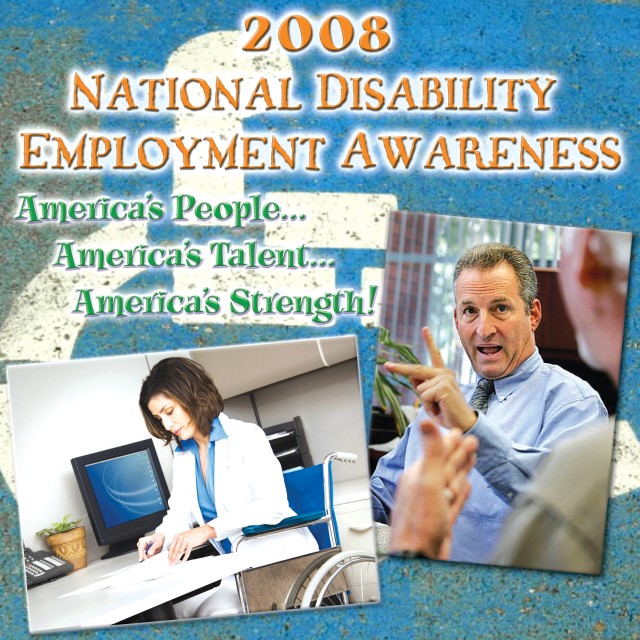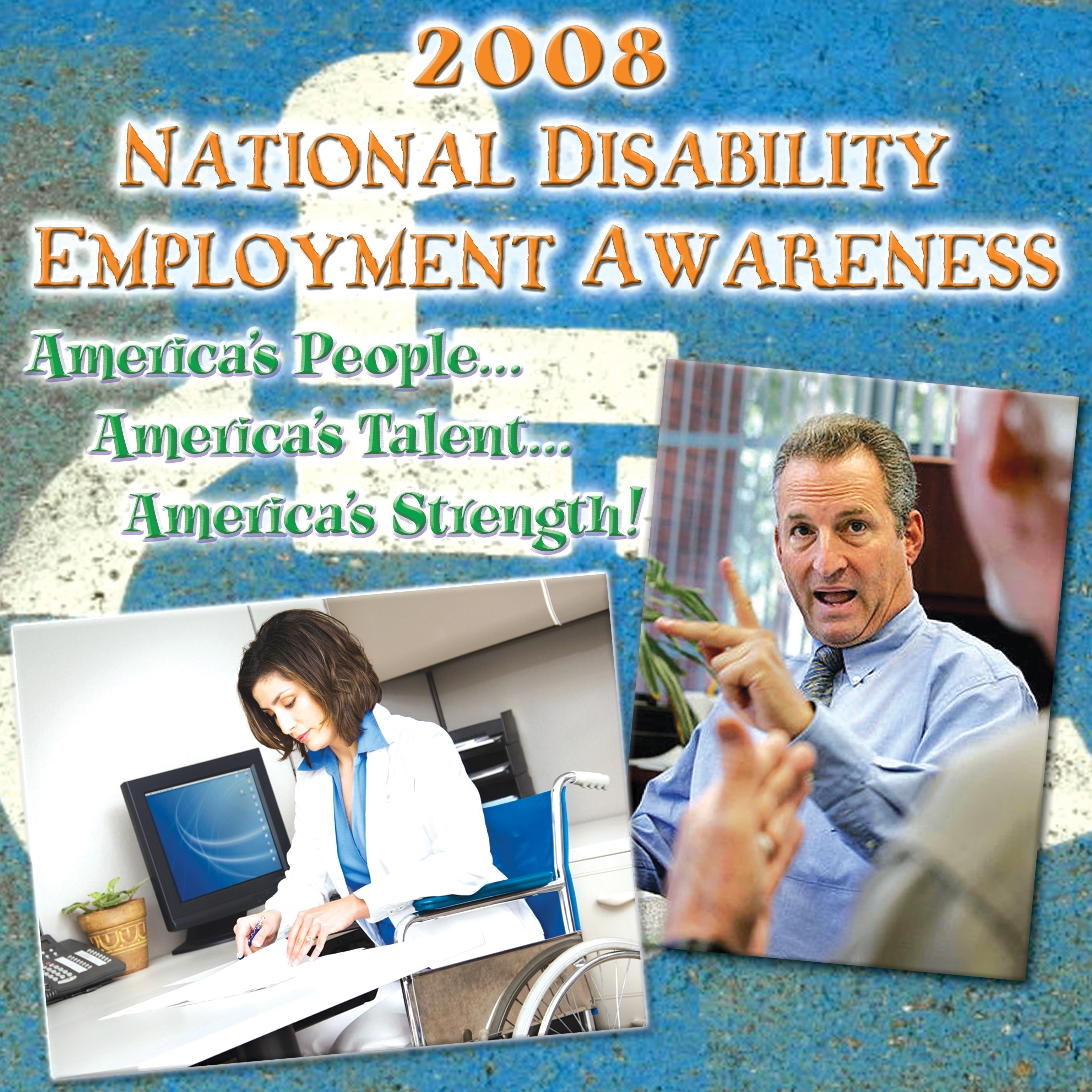This article is the first in a five-part series regarding working with employees who have disabilities. Check on the latest updates in the next edition of the Sentinel.
FORT MCPHERSON, Ga. -- Despite medical and technological advancements that offer greater opportunities for people with disabilities to work, their participation rate in the federal workforce has steadily declined while the overall federal workforce has actually grown. Currently, disabled employees represent 0.92 percent of the federal workforce, a decrease of nearly 15 percent since 1997, according to the U.S. Equal Employment Opportunity Commission (EEOC).
"There are laws and regulations [on] the need to go out and hire and recruit people with disabilities," announced Christine Griffin, commissioner of the EEOC, at a July 23 conference in Washington, D.C.
Griffin called upon the federal government to set a goal of increasing the representation of disabled people in the workforce to 2 percent by 2010. "We have more of a hook, frankly. Our hook is that we actually have laws and regulations that say to the federal government, you need to do a good job in this area. And frankly, despite these laws, we are doing a terrible job."
An EEOC report released in January called upon the federal government to be the nation's model employer, providing equal opportunity to all Americans, including those with disabilities. Among the highlighted obstacles that currently hinder the employment of people with disabilities is the lack of knowledge that agency officials have about how to appropriately respond to reasonable accommodation requests.
For individuals with disabilities, normal workplace conditions may be workplace barriers, preventing them from carrying out their essential daily functions. These barriers may be physical obstacles, such as inaccessible facilities or equipment. They may also be in the form of procedures or policy, such as unbendable work schedules and deadlines, when breaks are taken or how tasks are performed. Reasonable accommodations remove these barriers for employees with disabilities.
A reasonable accommodation is any change in the work environment or in the way a job is performed that enables a person with a disability to enjoy equal employment opportunities. There are three categories of reasonable accommodation: changes to a job application process; changes to a work environment or to the way a job is usually done; and changes that enable an employee with a disability to enjoy equal benefits and privileges of employment, such as access to training.
A person with a disability is qualified for a job if he or she can perform the essential functions of that job with or without the reasonable accommodation. Employers must make sure that once hired, individuals with disabilities have the tools they need to succeed and the same opportunities for advancement as other employees.
Even though the employer must ensure employees with disabilities receive the proper tools they need to perform their jobs efficiently, it is not the employer's job to recognize the disability, especially when some disabilities cannot be seen based on appearance alone. Furthermore, it is illegal for an employer to ask about an applicant's disability before a job offer has been made.
"You can ask an employee during an interview if they can perform the essential functions of their job, and that's it," explained Lana Layton, an administrative judge for the EEOC at a recent Reasonable Accommodation Training Seminar held at the Fort McPherson Post Theater. "Once they're hired, then you can ask if they need an accommodation to help them perform the essential functions of the job."
The interview process is an applicant's opportunity to convince the employer that he or she is best qualified for the job. Employers are required to make reasonable accommodations during the application and interview process of individuals with a known disability. This may mean conducting the interview somewhere accessible to a person in a wheelchair or providing a sign language interpreter for a person who is deaf. These legal protections, as efficient as they are, are insufficient if individuals involved in the interview process are unaware of them.
After being hired, the employer must be aware of an existing disability. This most often means that the employee must tell the employer that he or she needs an accommodation.
"Whenever you have an employee come up to you and say that they need an accommodation, the next step is to engage in an interactive process," Layton explained.
During this interactive process, the employer and employee need to discuss what is needed for the employee to perform his or her job in regards to accommodations.
To ensure there are no misunderstandings regarding the exact accommodation an employee is requesting, the requesting employee must complete a Confirmation of Request for Reasonable Accommodation.
The form can be found on page 17 of the Installation Management Command-Southeast Region Memo-randum 690-1 (Equal Employment Opportunities Reasonable Accom-modations for Individuals with Disabilities), which is available to individuals with Fort McPherson and Fort Gillem Portal access at macgil.forscom.army.mil/eeo/default.aspx. The memorandum is also available at the U.S. Army Garrison Equal Employment Opportunity (EEO) office in Bldg. 63 at Fort McPherson.
"The individual with a disability requesting a reasonable accommodation should submit the request to the director or decision maker of their organization," explained Patricia E. Duncan, garrison EEO specialist.
The employer may choose among reasonable accommodations, as long as the chosen accommodation is effective.
"Preference is given to an employee's accommodation request, but it's the agency's decision," Layton emphasized.
Agencies must provide reasonable accommodations to qualified employees and applicants with disabilities, unless the accommodation would create an undue hardship on the everyday operations of the agency. An undue hardship is an action that requires significant difficulty or expense in relation to the overall size of the agency's program with respect to the number of employees, the number and type of facilities and size of budget; the type of operation, including the composition and structure of the agency's workforce; and the nature and cost of the accommodation.
Undue hardship must be based on an individualized assessment of current circumstances and show how a specific reasonable accommodation would cause significant difficulty or expense. The cost of an accommodation and the availability of alternate accommodations are also factors in determining if an accommodation would be an undue hardship.
Undue hardship may be determined based on the net cost to the employer. Layton does not see any reasonable accommodation causing large agencies a financial undue hardship. "Especially in agencies such as the Army, it's going to have to cost a lot of money to say 'we can't do this for you,'" Layton said.
Undue hardship is not limited to financial difficulty; it may also be caused by a reasonable accommodation that is unduly extensive or disruptive, or one that would fundamentally alter the nature or operation of the business. However, an employer cannot claim undue hardship based on employees' fears or prejudice, or because providing a reasonable accommodation might have a negative impact on employee morale.
Also, an employer doesn't have to modify the work hours of an employee with a disability if doing so would prevent other employees from performing their jobs. The significant disruption to the operations of the employer constitutes an undue hardship.
Because the amount of time it takes to respond to a reasonable accommodation request depends on the nature of the accommodation, there is no specific timeline. Time limits should, however, be as short as reasonably possible.
Once an accommodation has been implemented, it is important to monitor it for success and continued appropriateness. People and situations change and it is important to recognize that reasonable accommodation is a process, not a one-time fix.
Reasonable accommodation allows agencies to expand their pool of qualified workers by giving them authorization to alter certain aspects of job functions to allow individuals with disabilities equal employment opportunities. It is vital that people with disabilities who can and want to work are supported in their efforts to do so, and such support is available because of the advent of reasonable accommodation. With reasonable accommodation, any pre-existing barriers in the workplace have been knocked down, and the doorway to equal employment opportunities has been propped open.




Social Sharing